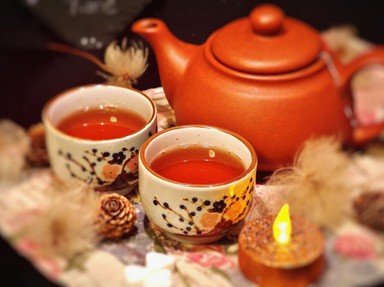Quiz Answer Key and Fun Facts
1. Chinese legend tells us that tea was discovered by Emperor Shen Nong, back in 2737 BC. How did that experimental gentleman brew the first cup of tea?
2. In Indian legend, tea had a more distressing beginning. Apparently, it was created in 529 by Prince Bodhi-Dharma. This saint vowed to meditate for nine years without sleep, but, unfortunately, he broke this vow let himself drift off. Upon awakening, what did he do to create the first tea plant?
3. No matter the legend, tea likely originated in China, Northern India, and Tibet, becoming especially popular during China's Tang Dynasty (618-907). Which two tea-related events coincided with each other during that age?
4. How did tea become so popular in Japan? Tea seeds were likely first brought there in the 9th century by Saichō, and later, a man named Eisai popularized grinding the leaves to make Matcha. These pioneering chaps never knew each other, but what linked them both (besides tea)? You don't have to shave your head for this one.
5. Tea drinking eventually made its way to Europe, thanks in part to the Dutch East India Company which took up trading it. If you found yourself sipping tea in Europe during the 17th century, who were you most likely to be?
6. During the 18th century, the British were becoming so mad about tea that the British Tea Committee came up with a strange way of learning about Chinese tea farming techniques. What did they do?
7. By 1773, tea was a firm fixture in households across the British Empire. A famous tea party that year in Boston was infamous for its revolutionary implications, however. In what sense was the event a tea party?
8. Britain's reliance on Chinese tea ended during the 19th century when a new type of tea was discovered and marketed in India. Which fragrant new brew became a hit?
9. The next step in the history of tea was the consumption of iced tea at the 1904 St. Louis, Missouri, World's Fair. What strange circumstances at that unusually hot event led to the popularization of iced tea?
10. One of the newest milestones in tea's development is the introduction of the tea bag. Perfect for steeping and sipping, how did the teabag originate?
Source: Author
lordprescott
This quiz was reviewed by FunTrivia editor
Bruyere before going online.
Any errors found in FunTrivia content are routinely corrected through our feedback system.
